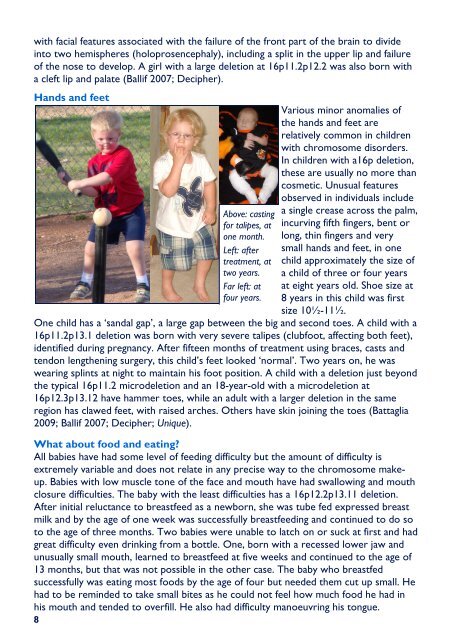16p proximal deletions - Unique - The Rare Chromosome Disorder ...
16p proximal deletions - Unique - The Rare Chromosome Disorder ...
16p proximal deletions - Unique - The Rare Chromosome Disorder ...
Create successful ePaper yourself
Turn your PDF publications into a flip-book with our unique Google optimized e-Paper software.
with facial features associated with the failure of the front part of the brain to divide<br />
into two hemispheres (holoprosencephaly), including a split in the upper lip and failure<br />
of the nose to develop. A girl with a large deletion at <strong>16p</strong>11.2p12.2 was also born with<br />
a cleft lip and palate (Ballif 2007; Decipher).<br />
Hands and feet<br />
Above: casting<br />
for talipes, at<br />
one month.<br />
Left: after<br />
treatment, at<br />
two years.<br />
Far left: at<br />
four years.<br />
Various minor anomalies of<br />
the hands and feet are<br />
relatively common in children<br />
with chromosome disorders.<br />
In children with a<strong>16p</strong> deletion,<br />
these are usually no more than<br />
cosmetic. Unusual features<br />
observed in individuals include<br />
a single crease across the palm,<br />
incurving fifth fingers, bent or<br />
long, thin fingers and very<br />
small hands and feet, in one<br />
child approximately the size of<br />
a child of three or four years<br />
at eight years old. Shoe size at<br />
8 years in this child was first<br />
size 10½-11½.<br />
One child has a ‘sandal gap’, a large gap between the big and second toes. A child with a<br />
<strong>16p</strong>11.2p13.1 deletion was born with very severe talipes (clubfoot, affecting both feet),<br />
identified during pregnancy. After fifteen months of treatment using braces, casts and<br />
tendon lengthening surgery, this child’s feet looked ‘normal’. Two years on, he was<br />
wearing splints at night to maintain his foot position. A child with a deletion just beyond<br />
the typical <strong>16p</strong>11.2 microdeletion and an 18-year-old with a microdeletion at<br />
<strong>16p</strong>12.3p13.12 have hammer toes, while an adult with a larger deletion in the same<br />
region has clawed feet, with raised arches. Others have skin joining the toes (Battaglia<br />
2009; Ballif 2007; Decipher; <strong>Unique</strong>).<br />
What about food and eating?<br />
All babies have had some level of feeding difficulty but the amount of difficulty is<br />
extremely variable and does not relate in any precise way to the chromosome makeup.<br />
Babies with low muscle tone of the face and mouth have had swallowing and mouth<br />
closure difficulties. <strong>The</strong> baby with the least difficulties has a <strong>16p</strong>12.2p13.11 deletion.<br />
After initial reluctance to breastfeed as a newborn, she was tube fed expressed breast<br />
milk and by the age of one week was successfully breastfeeding and continued to do so<br />
to the age of three months. Two babies were unable to latch on or suck at first and had<br />
great difficulty even drinking from a bottle. One, born with a recessed lower jaw and<br />
unusually small mouth, learned to breastfeed at five weeks and continued to the age of<br />
13 months, but that was not possible in the other case. <strong>The</strong> baby who breastfed<br />
successfully was eating most foods by the age of four but needed them cut up small. He<br />
had to be reminded to take small bites as he could not feel how much food he had in<br />
his mouth and tended to overfill. He also had difficulty manoeuvring his tongue.<br />
8

















